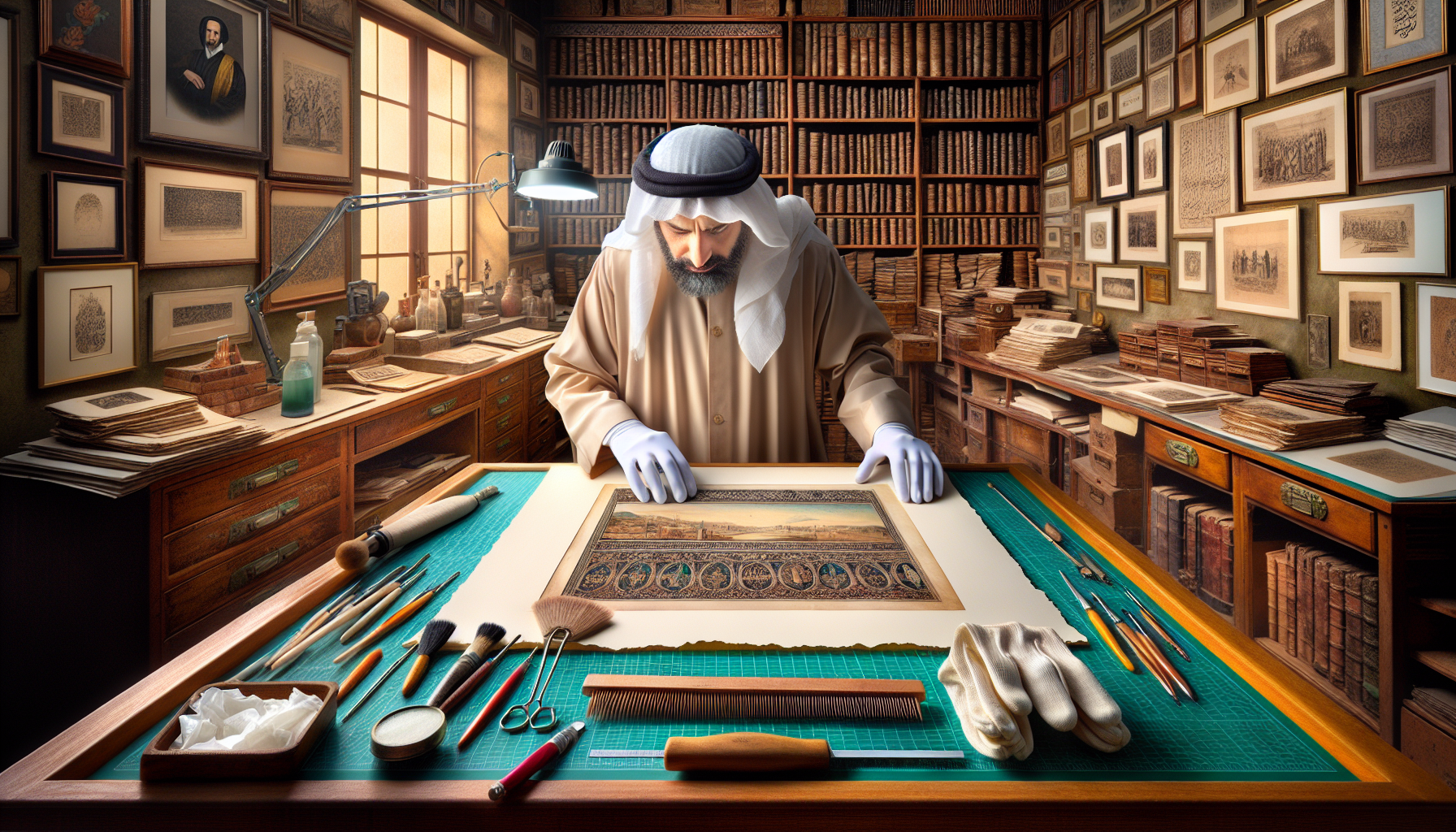In the hushed ambiance of a dimly lit gallery or the quiet corners of a personal art collection, lithographs often stand as silent testaments to human creativity and history. These intricate works of art, produced through the meticulous process of lithography, capture not only the essence of the artist’s vision but also the spirit of the era they originate from. However, as with all treasures, the passage of time poses a formidable challenge to their preservation. Whether you’re a seasoned collector, an art enthusiast, or a custodian of family heirlooms, understanding the nuances of lithograph preservation is essential to safeguarding these artistic legacies for future generations. 🎨
Lithography, a technique that has been enchanting artists and audiences alike since the late 18th century, involves a delicate dance between oil and water, etched stones or metal plates, and a keen artistic eye. The resultant prints are celebrated for their rich textures and vivid expressions, each telling its own unique story. Yet, the very nature of lithographs—crafted from paper, inks, and delicate surfaces—renders them susceptible to a variety of environmental and human-induced factors. From the detrimental effects of light exposure to the silent, creeping threat of humidity, numerous elements can conspire to compromise the integrity of these pieces. In this article, we delve into the expert strategies that can help you master the art of lithograph preservation, ensuring that your cherished prints continue to inspire awe for years to come.
Our journey begins by unraveling the science behind lithograph materials and the common adversities they face. By gaining insight into the composition and vulnerabilities of these works, you’ll be better equipped to implement effective preservation techniques. We will explore the effects of environmental conditions, such as light, temperature, and humidity, and discuss how they can be meticulously controlled to create the ideal sanctuary for your lithographs. Furthermore, we will examine the crucial role of proper handling and storage, offering practical advice on the best practices to prevent accidental damage and deterioration.
In the subsequent sections, we will dive into the specialized tools and materials that professionals recommend for lithograph care. From archival-quality storage solutions to UV-protective glass and conservation-grade framing, these tools are indispensable in the fight against time. You will discover how to evaluate and choose the right products that align with your specific needs, balancing aesthetic considerations with the imperatives of preservation. Additionally, we will address the importance of regular inspection and maintenance, emphasizing how routine checks can catch early signs of damage and prolong the life of your collection.
Finally, we will touch upon the human element of lithograph preservation—an aspect often overlooked but immensely significant. This includes understanding the stories behind your pieces, connecting with fellow art lovers and professionals, and fostering a culture of appreciation and respect for these works. After all, the preservation of lithographs is not merely a technical endeavor; it is a commitment to nurturing the cultural and emotional narratives encapsulated within each print.
As we embark on this exploration of lithograph preservation, prepare to immerse yourself in a world where art and science intersect, where passion meets precision. Whether you aim to preserve a single piece or an entire collection, this guide will equip you with the knowledge and tools to protect your artistic treasures with confidence and care. Let’s turn the page and begin this journey into the mastery of lithograph preservation. 🌟
The Art of Lithography: An Overview
Lithography is an intricate printing process that dates back to the late 18th century. It involves creating images on a flat stone or metal plate using a greasy substance, then applying ink that sticks to the grease while being repelled by the surrounding water. This method allows for high-quality reproductions of art and has been cherished by artists and collectors alike. The allure of lithography lies in its ability to produce vibrant images with subtle gradations of color and tone, making it a favored medium for artists such as Henri de Toulouse-Lautrec and Pablo Picasso.
Understanding the history and technique of lithography is crucial for those interested in preserving these masterpieces. The process was invented by Alois Senefelder in 1796, who discovered that a greasy crayon drawn on limestone would attract ink and repel water. This technique quickly spread across Europe and the world, with artists and printers embracing its versatility. Over time, lithography has evolved, incorporating modern technologies while maintaining its traditional roots.
Collectors and enthusiasts often face challenges when it comes to preserving lithographs. These works are susceptible to environmental damage, such as fading from light exposure or degradation from humidity and pollutants. Proper preservation techniques are essential to ensure the longevity of these artistic treasures, allowing future generations to appreciate their beauty and historical significance.
The Evolution of Lithography
Over the years, lithography has undergone significant transformations. Initially, it was a manual and labor-intensive process, but technological advancements have streamlined production while retaining the essence of the art form. Modern lithographic techniques include offset printing and digital lithography, which have expanded the medium’s possibilities and applications.
The rise of offset lithography in the 20th century marked a turning point for the industry. This method uses rubber rollers to transfer the image from the lithographic plate to paper, offering faster production speeds and higher quality prints. Offset lithography became the standard for commercial printing, widely used in publishing, advertising, and packaging.
Digital lithography has further revolutionized the field by allowing artists to create images using computer software. This approach offers greater precision and flexibility, enabling artists to experiment with new styles and techniques. Despite these advancements, traditional stone lithography remains a revered art form, cherished for its authenticity and craftsmanship.
Preservation Challenges and Solutions
Preserving lithographs requires understanding the various threats they face. Environmental factors such as light, temperature, humidity, and pollutants can cause significant damage if not properly managed. Each of these elements can impact the longevity and appearance of lithographs, necessitating strategic preservation measures.
Light exposure is one of the most common threats to lithographs, as UV rays can cause fading and discoloration. To mitigate this risk, it’s advisable to display lithographs away from direct sunlight or use UV-filtering glass in frames. Additionally, maintaining a stable temperature and humidity level is crucial, as fluctuations can lead to paper warping and mold growth. Ideal conditions typically involve temperatures between 18-22°C and humidity levels around 50%.
Another critical aspect of preservation is handling and storage. Lithographs should be stored in acid-free materials and handled with clean hands or gloves to prevent oils and dirt from transferring onto the artwork. Regular inspections can help identify potential issues early, allowing for timely interventions.
Advanced Preservation Techniques
For collectors seeking to preserve their lithographs for the long term, investing in professional conservation services may be beneficial. Conservators can perform delicate repairs and treatments to restore damaged lithographs, utilizing advanced techniques such as deacidification, tear repair, and consolidation of flaking pigments.
Conservation framing is another effective strategy, providing an added layer of protection for displayed lithographs. This involves using archival-quality materials and methods to frame artwork, ensuring that it remains safe from environmental hazards. For those with extensive collections, climate-controlled storage facilities offer optimal conditions for preserving lithographs, safeguarding them from potential harm.
Technology also plays a role in preservation, with digital archiving allowing for high-resolution documentation of lithographs. This can serve as a backup in case of damage or loss and provides a means of sharing and studying the artworks without risking physical harm.
Comparing Preservation Techniques
When considering preservation methods, it’s essential to weigh the pros and cons of each approach. The table below provides a comparison of common techniques used to safeguard lithographs:
| Technique | Advantages | Disadvantages |
|---|---|---|
| UV-Filtering Glass | Protects against light damage, maintains image integrity | Can be costly, potential for glare |
| Acid-Free Storage | Prevents chemical degradation, affordable | Requires space, regular monitoring needed |
| Professional Conservation | Expert restoration, tailored solutions | Expensive, may require ongoing maintenance |
| Digital Archiving | Preserves image quality, easy sharing | No physical preservation, tech-dependent |
It’s essential to choose the right combination of techniques based on individual needs and circumstances. For example, a home display might benefit from UV-filtering glass and regular inspections, while a large collection could require climate-controlled storage and digital archiving.
Community and Resources
Connecting with other collectors and experts can provide valuable insights into lithograph preservation. Online forums, workshops, and seminars offer opportunities to learn from others’ experiences and share knowledge. Engaging with these communities can enhance one’s understanding of preservation techniques and foster a network of support.
There are numerous resources available for those seeking to deepen their knowledge of lithograph preservation. Books, articles, and online courses offer detailed guidance on various aspects of care and conservation. Additionally, organizations such as the International Institute for Conservation (IIC) and the American Institute for Conservation (AIC) provide valuable information and support for those dedicated to preserving art.
For a visual exploration of lithograph preservation techniques, watch the video below, which delves into practical steps and tips for safeguarding these precious artworks:
Mastering Lithograph Preservation – Pro Tips and Techniques by Art Conservation Channel
By staying informed and proactive, collectors can ensure their lithographs remain vibrant and intact for years to come.

Conclusion
Conclusion: Mastering Lithograph Preservation
In delving into the art of lithograph preservation, we have explored a myriad of techniques and insights essential for safeguarding these exquisite pieces of artistic heritage. This journey has illuminated the significance of understanding the unique vulnerabilities of lithographs and the meticulous care required to ensure their longevity. Let us recapitulate the key points discussed and underscore the importance of this endeavor.
Firstly, we examined the intrinsic characteristics of lithographs that necessitate special attention. Unlike other art forms, lithographs are particularly susceptible to environmental factors such as light, humidity, and temperature fluctuations. This sensitivity underscores the necessity for controlled storage conditions, which we elaborated on, emphasizing the importance of maintaining a stable environment with moderate temperature and humidity levels. Furthermore, the use of UV-filtering glass and acid-free materials was highlighted as a protective measure against the deleterious effects of light and acidity.
Secondly, we delved into the specifics of handling and cleaning lithographs. It became evident that the fragility of the paper and the delicate nature of the inks demand a gentle touch and informed techniques. We discussed best practices for handling, which include the use of clean, dry hands or gloves, and the importance of supporting the artwork from underneath to prevent stress on the paper. Cleaning, we learned, should be approached with caution, opting for professional restoration services when in doubt, to avoid accidental damage.
Furthermore, we explored the role of framing and display in lithograph preservation. Proper framing not only enhances the aesthetic appeal but also serves as a crucial protective barrier against dust, pollutants, and physical damage. We emphasized the importance of using archival-quality materials and ensuring that the lithograph does not come into direct contact with the glass, to prevent condensation and potential sticking.
The preservation of lithographs is not just a technical task but an act of cultural preservation. These artworks are windows into the past, offering insights into historical and artistic movements. Their preservation ensures that future generations can appreciate and learn from them, making it a responsibility of both collectors and enthusiasts.
The importance of mastering lithograph preservation cannot be overstated. In a world where cultural heritage is constantly at risk, every effort to protect these treasures contributes to the broader endeavor of preserving human history and creativity. We encourage you to apply the knowledge gained from this discussion, whether in your personal collection or in broader preservation efforts.
As we conclude this exploration, we invite you to share your thoughts and experiences. Have you implemented any of these techniques in your own preservation efforts? What challenges have you encountered, and how have you overcome them? Your insights could be invaluable to fellow art enthusiasts and preservationists.
We also encourage you to share this article with others who may benefit from these insights. By spreading awareness and knowledge, we collectively contribute to the safeguarding of artistic heritage. Remember, the care we invest in today’s art will ensure its legacy for tomorrow’s admirers.
Finally, continue your learning journey by exploring the wealth of resources available on lithograph preservation. Websites such as Smithsonian Institution Archives and The Getty Conservation Institute offer valuable insights and up-to-date research in the field of art preservation. These platforms are excellent starting points for those looking to deepen their understanding and refine their preservation techniques.
In closing, may your passion for art and dedication to its preservation inspire others to join in this noble endeavor. Together, we can ensure that these artistic treasures endure, enriching our lives and those of generations to come. Let us preserve with care, appreciate with understanding, and share with enthusiasm. 🌟
Thank you for joining us on this journey of discovery and preservation. We look forward to your contributions and shared passion for the art of lithography.
Toni Santos is a visual storyteller and archival artisan whose creative journey is steeped in the bold colors, dramatic typography, and mythic imagery of old circus posters. Through his artistic lens, Toni breathes new life into these once-lurid canvases of wonder, transforming them into tributes to a golden era of spectacle, showmanship, and cultural fantasy.
Fascinated by the visual language of vintage circuses — from roaring lions to gravity-defying acrobats, from hand-painted banners to gothic typefaces — Toni explores how these posters once captured the imagination of entire towns with nothing more than ink, illusion, and a promise of awe. Each composition he creates or studies is a dialogue with history, nostalgia, and the raw aesthetics of entertainment on the move.
With a background in handcrafted design and visual heritage, Toni blends artistic sensitivity with historical insight. His work traces the forgotten typographies, chromatic choices, and symbolic flair that defined circus marketing in the 19th and early 20th centuries — a time when posters were not just advertisements, but portable portals to dreamworlds.
As the creative force behind Vizovex, Toni curates collections, illustrations, and thoughtful narratives that reconnect modern audiences with the magic of old circus art — not just as ephemera, but as cultural memory etched in paper and pigment.
His work is a tribute to:
The flamboyant storytelling of early circus posters
The lost art of hand-lettered show promotion
The timeless charm of visual fantasy in public space
Whether you’re a vintage print enthusiast, a circus history lover, or a designer inspired by antique aesthetics, Toni invites you into a world where tigers leap through fire, strongmen pose in perfect symmetry, and every corner of the poster whispers: Step right up.





